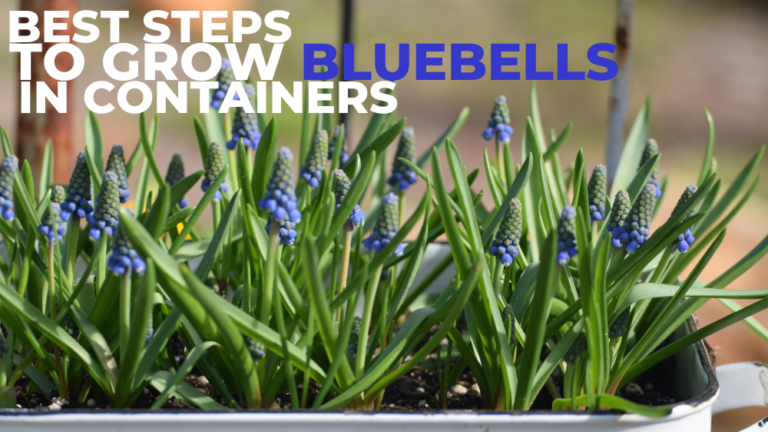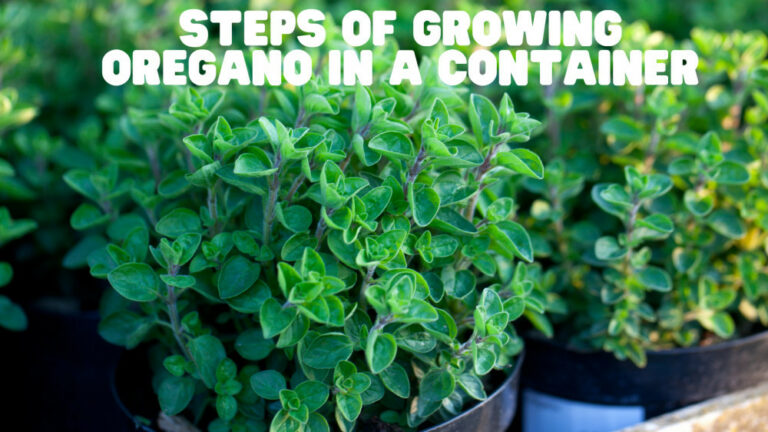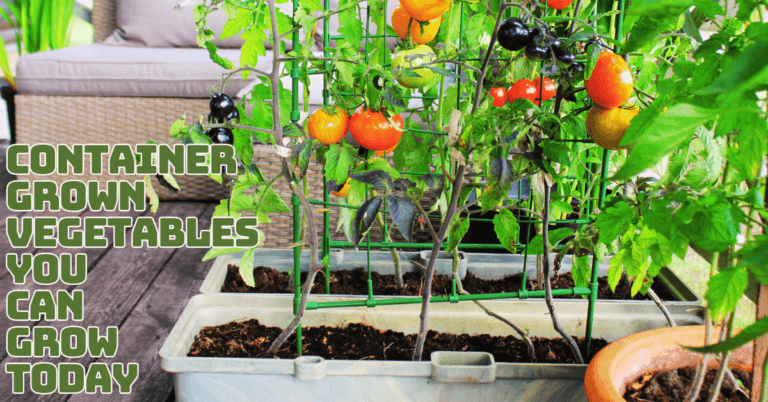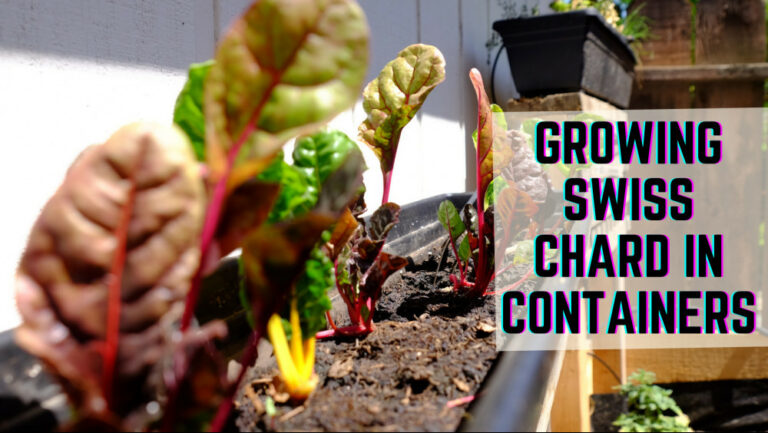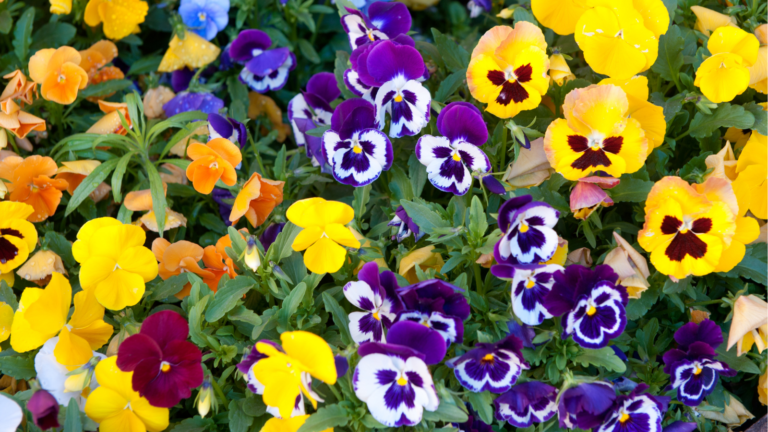Indoor Orchid Plants That Transform Your Space
Indoor Orchid Plants That Transform Your Space
Indoor Orchid Plants bring elegance and tranquillity to any space with their stunning blooms and graceful presence. These exotic flowers can enhance your home décor effortlessly, creating a serene and sophisticated atmosphere.
Whether you're a seasoned plant lover or a beginner, orchids offer a low-maintenance yet striking addition to your indoor oasis. Discover the best varieties and essential care tips to help your orchids thrive!
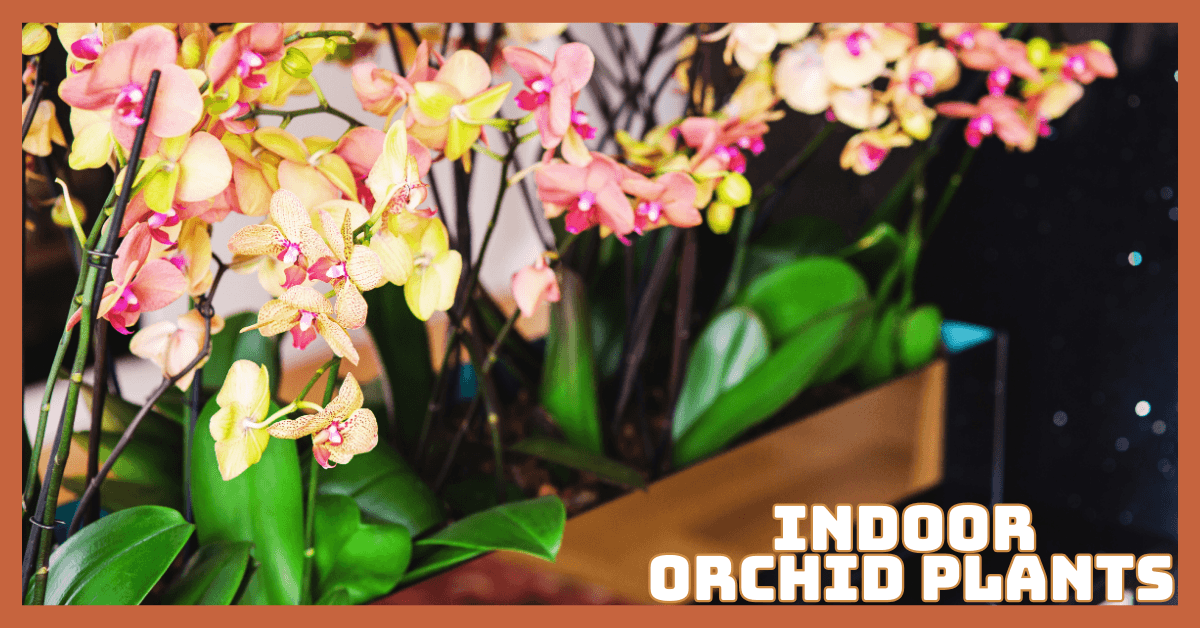
Best Indoor Orchid Varieties
Orchids come in numerous species and hybrids, each with unique characteristics. Here are some of the most popular types of indoor orchids:
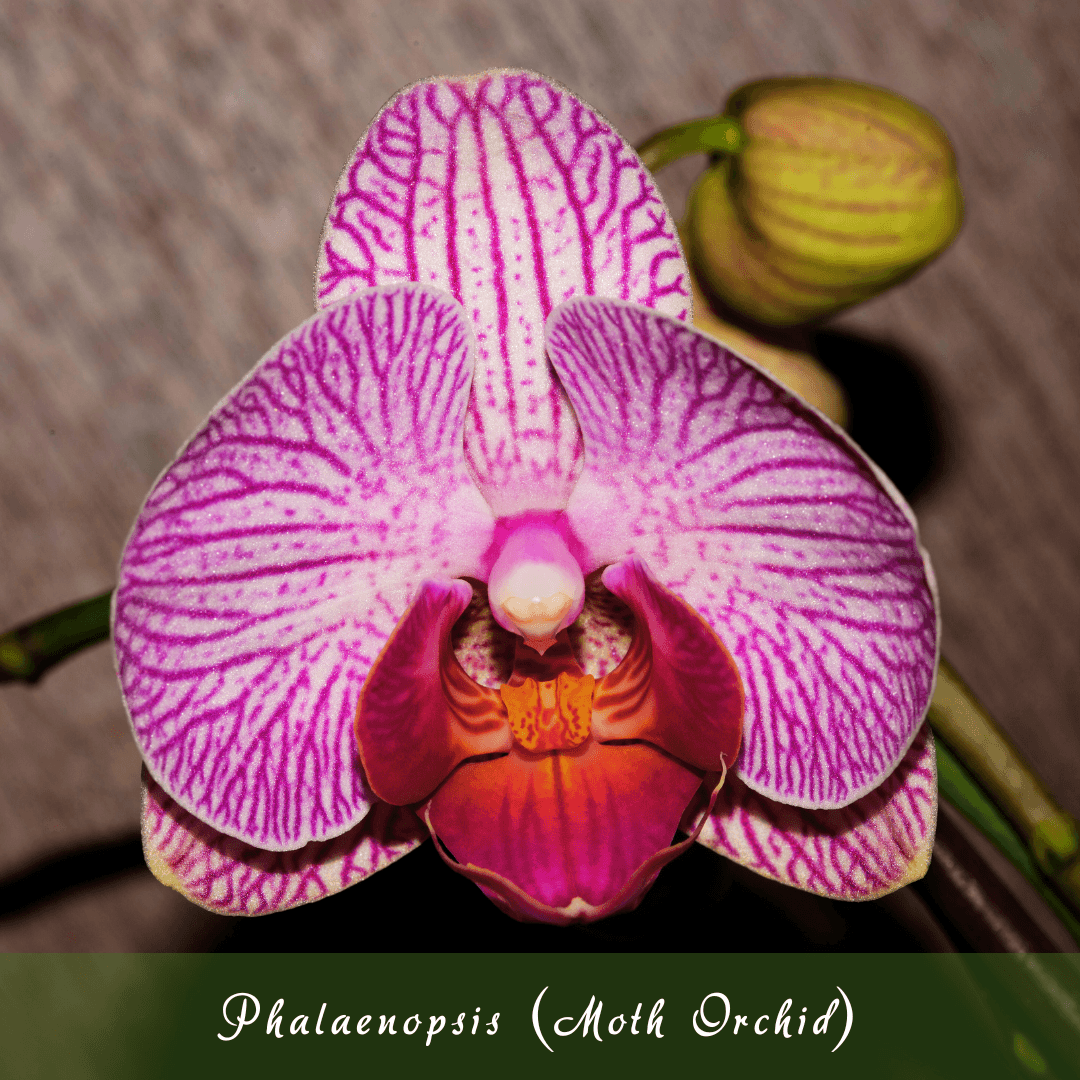
1. Phalaenopsis (Moth Orchid)
Growing Zone
USDA Zones 10-11. These elegant orchids feature broad, glossy green leaves and arching stems adorned with butterfly-like flowers in shades of white, pink, yellow, and purple. Their blooms can last for months, making them a favorite among orchid enthusiasts.
How To Grow
Place Phalaenopsis orchids in bright, indirect light with temperatures between 65-75°F (18-24°C). Water weekly, allowing roots to dry slightly.
Use a well-draining orchid mix and fertilize monthly with a balanced orchid fertilizer. Maintain humidity around 50-70% and trim spent flower spikes for reblooming. Repot every 2-3 years when roots outgrow the pot.
Care Tips
Water when the potting medium is dry, ensuring it drains well. Maintain humidity between 50% and 70%. Fertilize bi-weekly with a balanced orchid fertilizer. After blooming, trim the spike back to promote fresh growth and encourage future blooms.
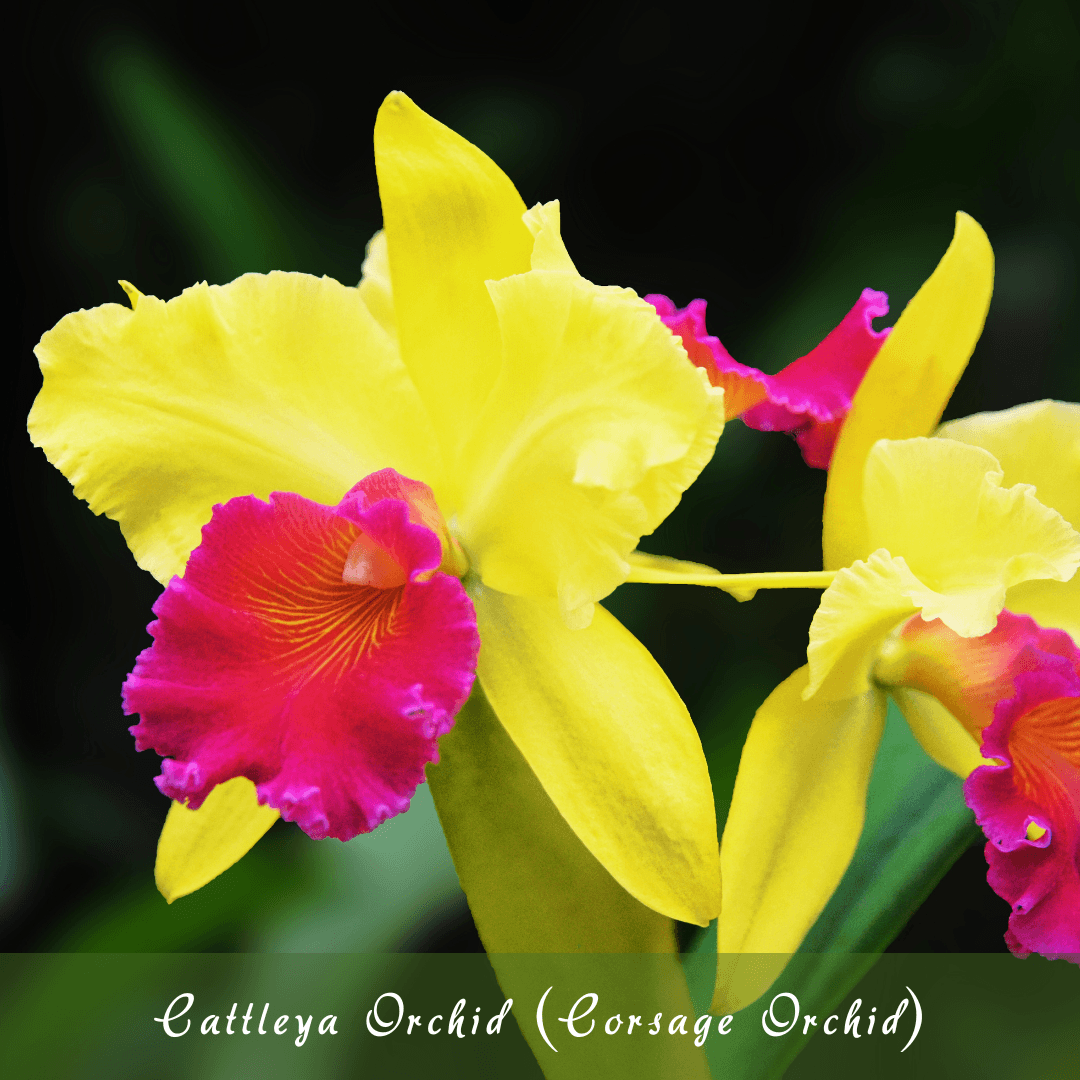
2. Cattleya Orchid (Corsage Orchid)
Growing Zone
USDA Zones 10-11. These stunning orchids are known for their large, ruffled flowers, which come in vibrant shades of pink, purple, yellow, white, and red. Their blossoms are often fragrant and have a waxy texture, making them popular for corsages and floral arrangements.
How To Grow
Cattleya orchids thrive in bright, indirect light and warm temperatures (65-80°F). Water when the potting mix is dry to ensure good drainage.
Use a bark-based mix and fertilize biweekly with orchid fertilizer. Maintain 50-70% humidity and provide good airflow. Repot every 2-3 years and trim old pseudobulbs to encourage new growth and blooms.
Care Tips
Water thoroughly when the potting medium is dry, allowing it to drain correctly. Cattleyas prefer a slightly drier environment.
Fertilize monthly during the growing season and give them a rest period after blooming to promote healthy growth.
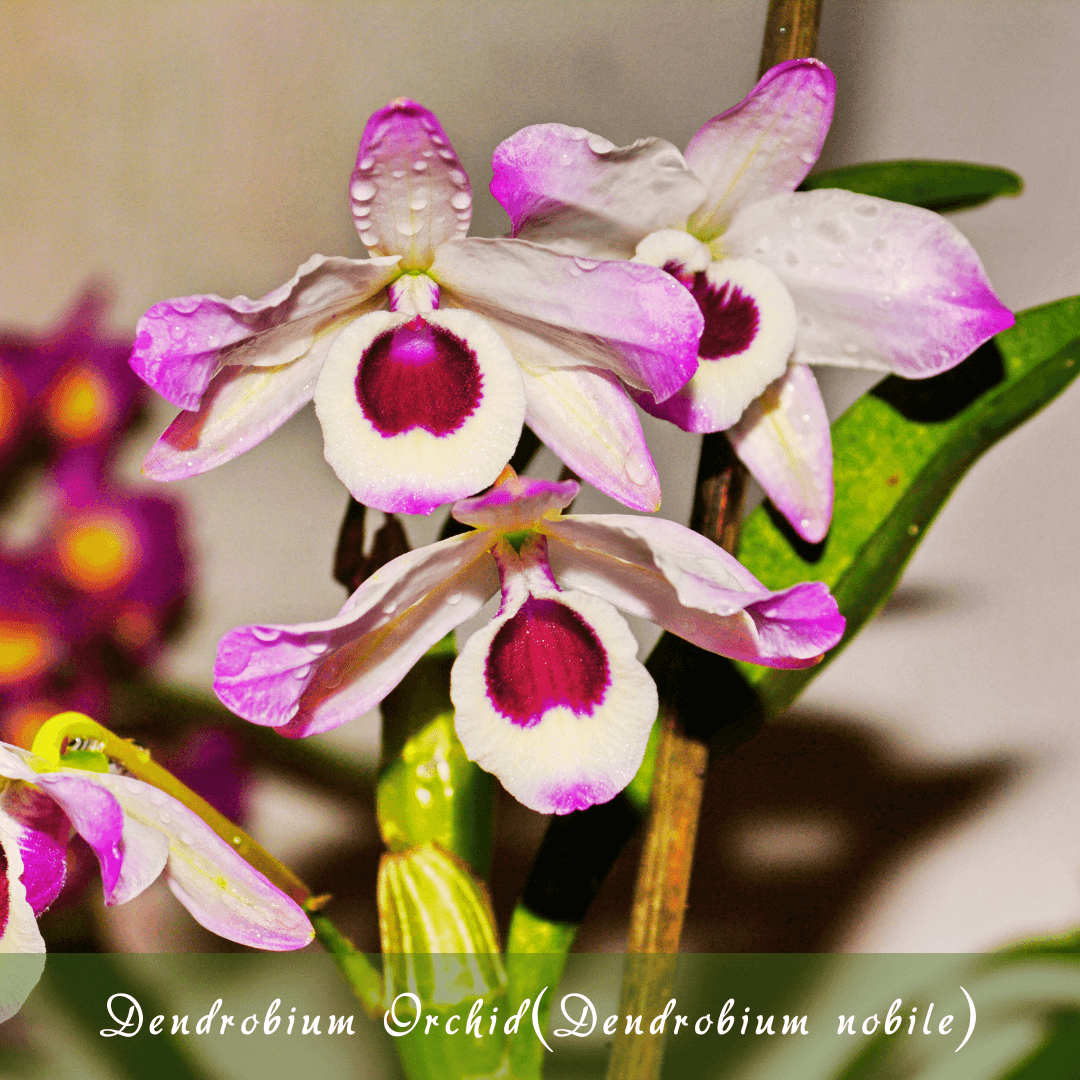
3. Dendrobium Orchid (Dendrobium nobile)
Growing Zone
USDA Zones 10-11. These orchids produce tall, slender canes with multiple blossoms ranging from white and pink to purple, yellow, and even green. Their flowers often have a contrasting lip and a delicate, waxy texture, making them a striking addition to any collection.
How To Grow
Dendrobium orchids prefer bright, indirect light and temperatures between 65-75°F (18-24°C). Water when the mix is dry, allowing roots to dry out between watering.
Use a well-draining orchid mix and fertilize every two weeks during active growth. Maintain humidity around 50-70%. Repot every two to three years, cutting back spent stems to promote new growth.
Care Tips
Indoor orchid plants require proper watering, a winter rest period, high humidity, and well-aerated roots for optimal growth.
Provide a remarkable winter rest period to encourage blooming. Maintain high humidity and mist occasionally to support healthy root growth. Keep roots well-aerated for optimal health.
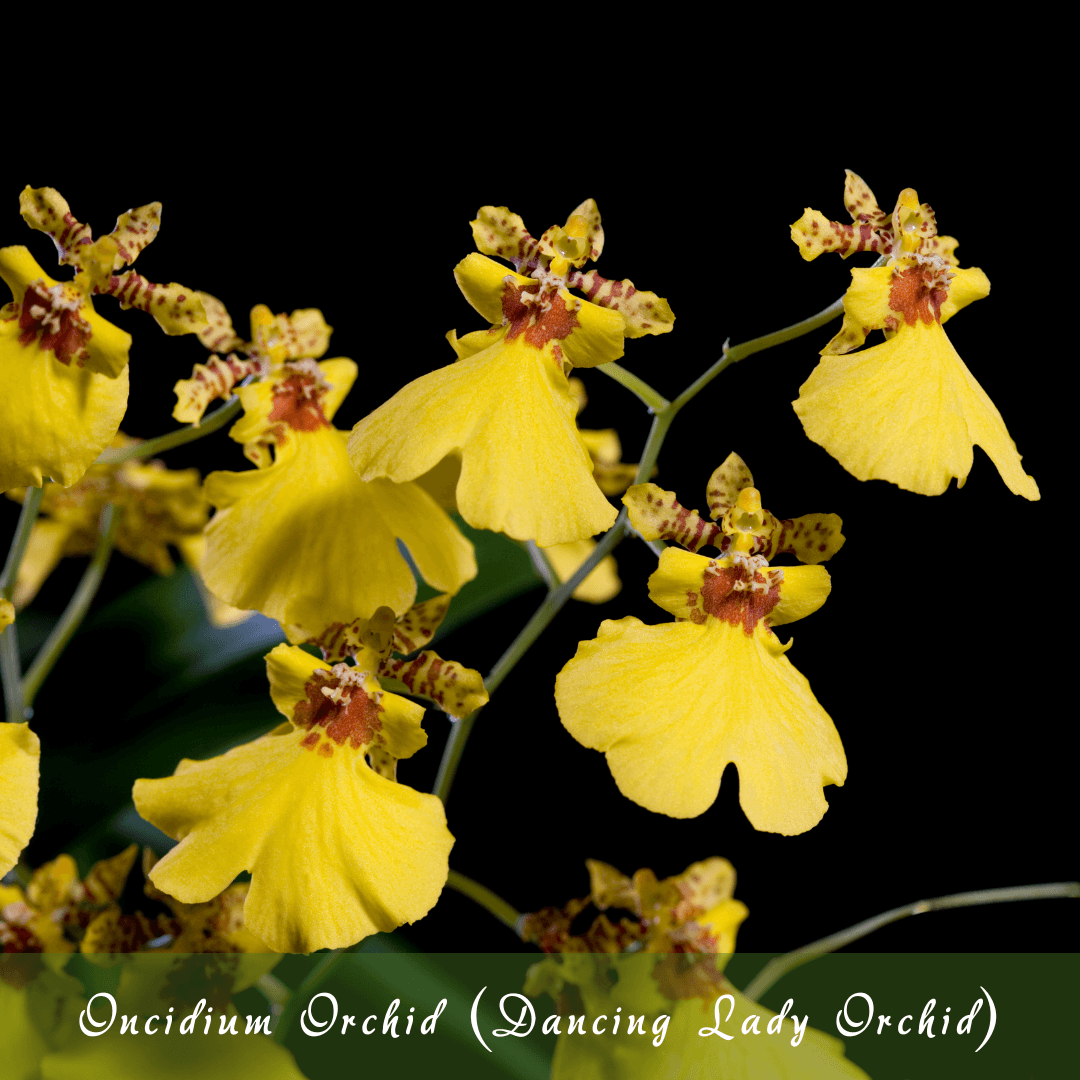
4. Oncidium Orchid (Dancing Lady Orchid)
Growing Zone
USDA Zones 10-11. These orchids are known for their sprays of small, delicate flowers that resemble dancing figures in flowing skirts.
Their blooms come in vibrant shades of yellow, red, pink, and brown, often with intricate patterns and a sweet fragrance.
How To Grow
Oncidium orchids thrive in bright, indirect light and temperatures between 60-80°F (16-27°C). Water when the mix is dry to ensure proper drainage.
Use a well-draining bark-based mix and fertilize every two weeks during growth. Maintain humidity around 40-60%. Repot every two to three years. Trim spent flower spikes to encourage future blooms.
Care Tips
Water when the medium is dry, ensuring good drainage. Maintain humidity levels around 50-60%. Fertilize with a balanced fertilizer once a month during the growing season. Remove unused blossoms to maintain the plant's health and promote future development.
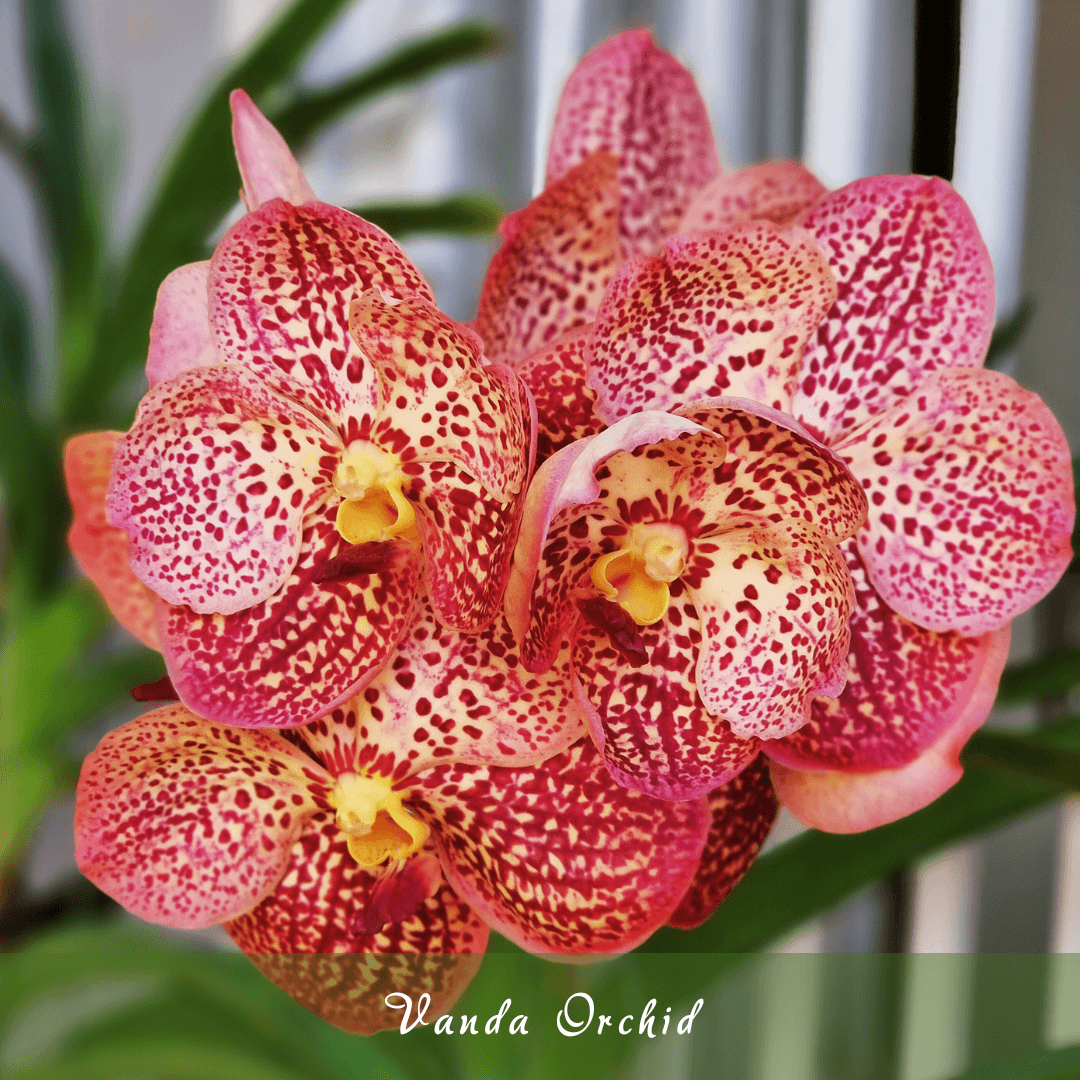
5. Vanda Orchid
Growing Zone
USDA Zones 10-11. Vandas are known for their striking, large flowers in vivid shades of blue, purple, pink, red, yellow, and white.
Their petals often have intricate patterns or spots. Vandas have long, strap-like leaves and are usually grown in hanging baskets, which allows their thick, aerial roots to remain exposed.
How To Grow
Vanda orchids require bright, direct light and warm temperatures (75-85°F/24-29°C). Water frequently, keeping the roots moist but not soggy, and allow the plant to dry between waterings.
Use a well-draining mix or grow them in a basket. Fertilize biweekly during growth. Maintain high humidity (60-80%) and ensure good airflow for healthy growth.
Care Tips
Water regularly to keep roots moist and ensure proper drainage. During the growing season, it is recommended that orchids be fertilized weekly with a balanced fertilizer.
Ensure they receive good air circulation and avoid waterlogging. Regular misting helps maintain humidity levels for optimal growth.
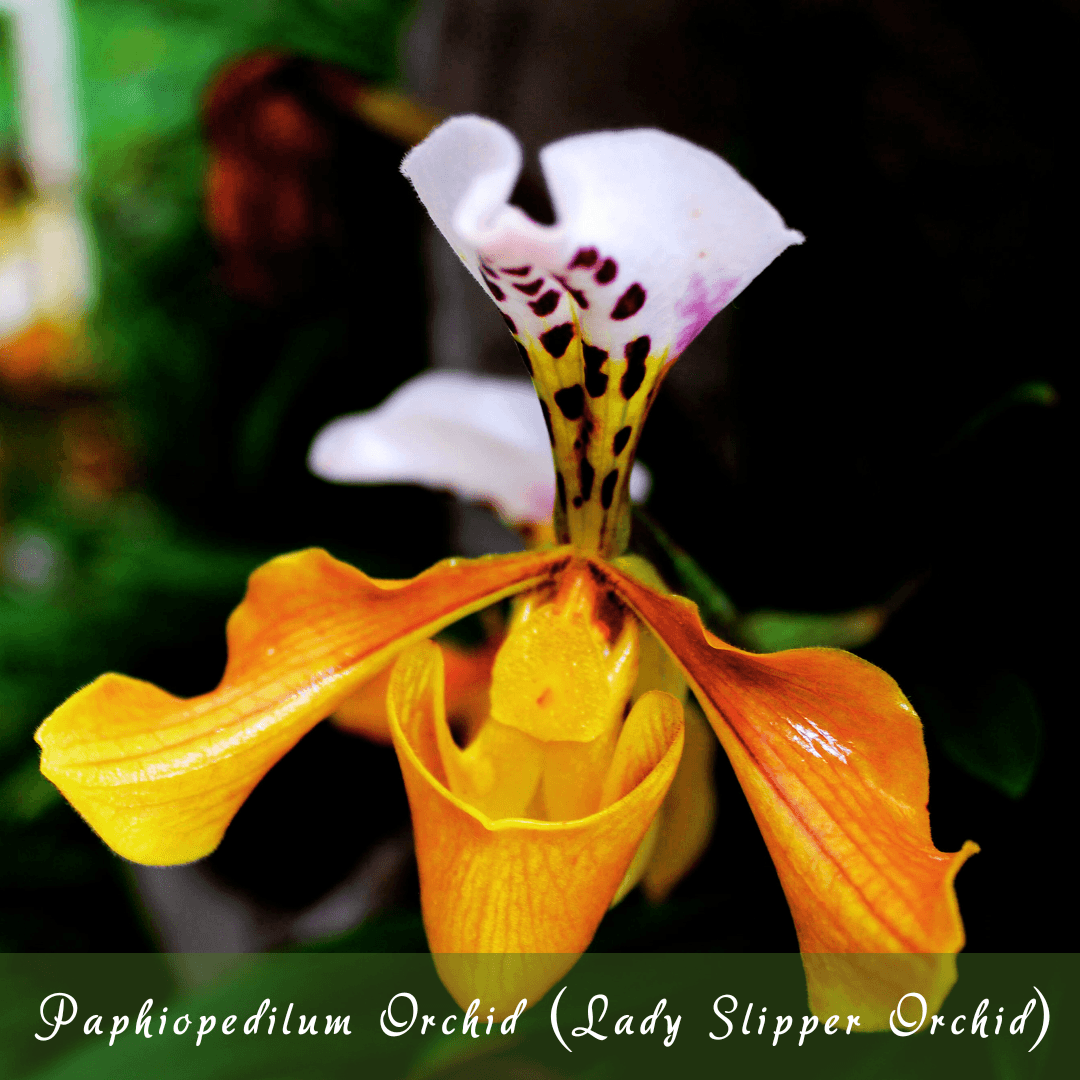
6. Paphiopedilum Orchid (Lady Slipper Orchid)
Growing Zone
USDA Zones 10-11. These unique orchids are known for their pouch-like blooms, which resemble a slipper, giving them their name.
Their flowers come in various colours, including green, yellow, pink, burgundy, and white, often with intricate patterns or speckled markings. Paphiopedilums have broad, leathery leaves that add to their striking appearance.
How To Grow
Paphiopedilum orchids prefer low to moderate light and temperatures between 65-75°F (18-24°C). Water when the potting mix is nearly dry, ensuring good drainage.
Use a well-draining, moisture-retentive mix like sphagnum moss or bark. Fertilize monthly during growth. Maintain humidity around 50-70%. Repot every 2-3 years and trim spent flower spikes.
Care Tips
Water indoor orchid plants when the potting mix feels dry, fertilize frequently, maintain appropriate humidity levels, and ensure adequate drainage to avoid root rot.
Fertilize with a balanced orchid fertilizer every two weeks during the growing period. Maintain humidity between 50% and 60% and ensure good drainage to prevent root rot.
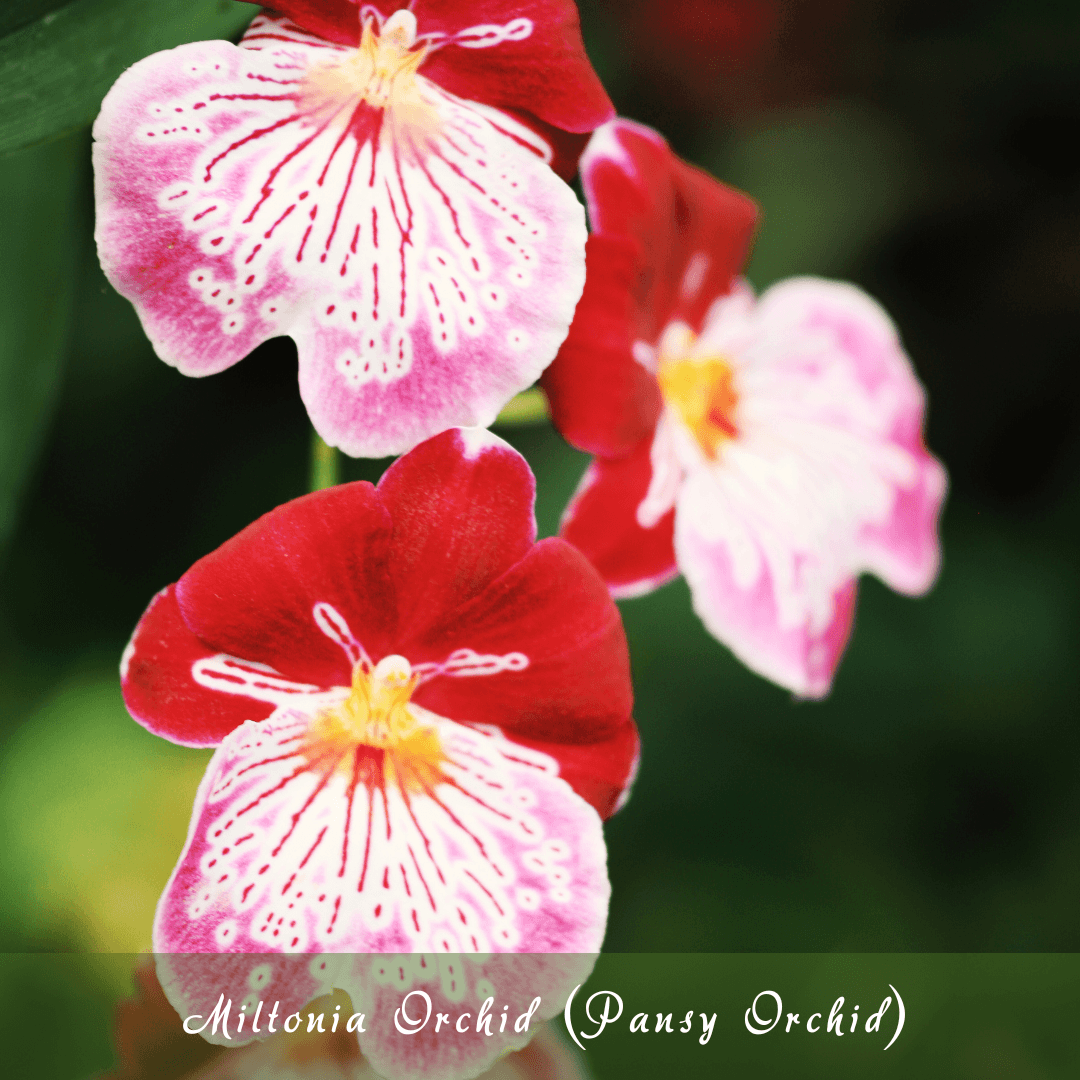
7. Miltonia Orchid (Pansy Orchid)
Growing Zone
USDA Zones 10-11. These orchids are admired for their large, flat flowers, which resemble pansies. Their soft, velvety petals and intricate patterns make the blooms stand out.
They come in shades of white, pink, purple, red, and yellow, often with striking markings or contrasting lips. The long and narrow foliage gives the plant an elegant appearance.
How To Grow
Miltonia orchids thrive in bright, indirect light and temperatures between 65-75°F (18 and 24°C). Water regularly when the mix is dry to ensure good drainage.
Use a well-draining orchid mix and fertilize every two weeks during active growth. Maintain humidity around 50-60%. Repot every two to three years. Trim spent flower spikes to encourage reblooming.
Care Tips
Water thoroughly when the soil is dry. Ensure proper drainage to avoid root rot. They require higher humidity, so misting helps. Fertilize bi-weekly during the growing season to encourage robust flowering and vibrant growth.
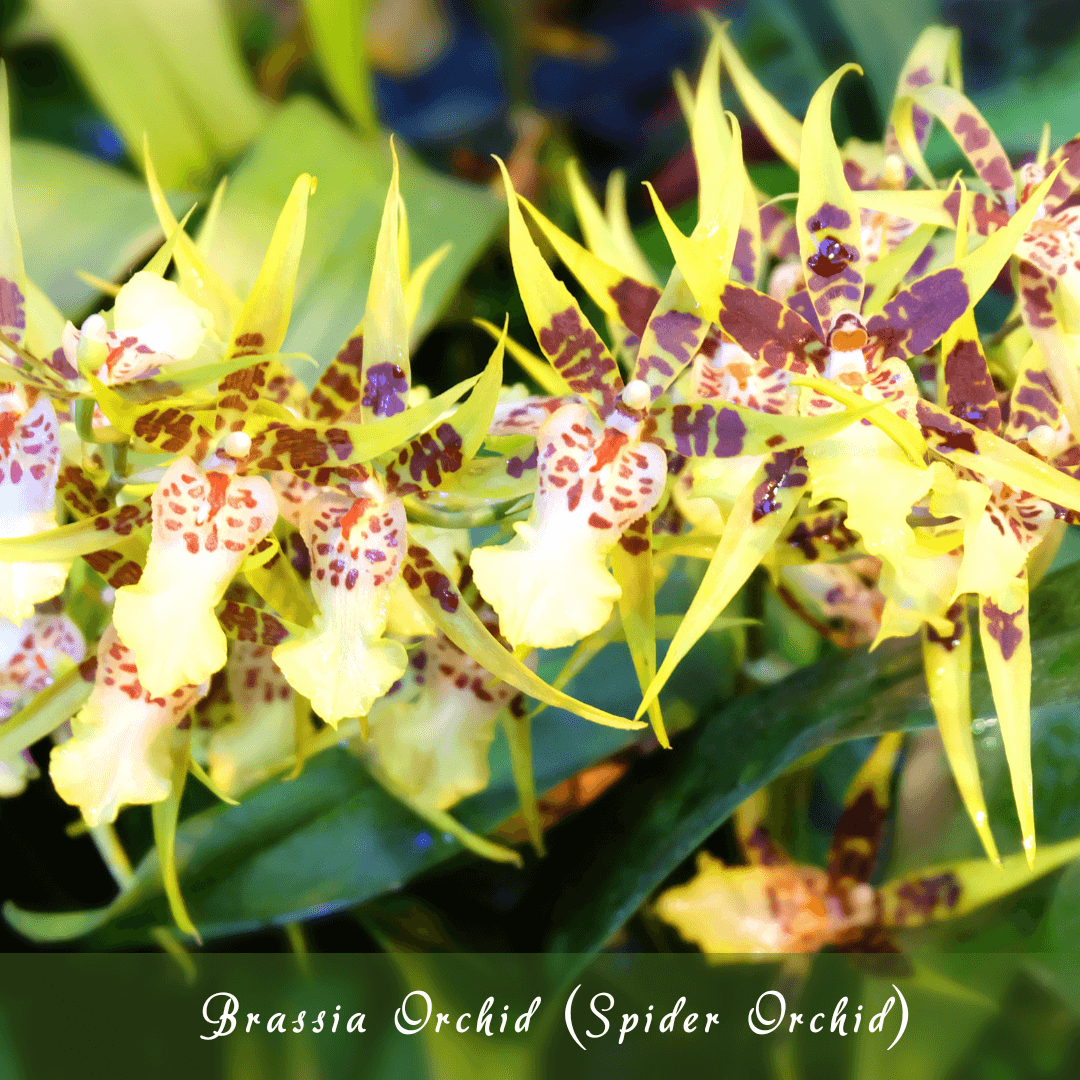
8. Brassia Orchid (Spider Orchid)
Growing Zone
USDA Zones 10-11. These exotic orchids are known for their long, slender petals that resemble spider legs, giving them their nickname.
Their blooms are typically greenish-yellow with dark brown or maroon spots, creating a striking contrast. Brassia orchids emit a pleasant fragrance and have elongated leaves that add to their elegant, airy appearance.
How To Grow
Brassia orchids thrive in bright, indirect light and temperatures between 65-80°F (18-27°C). Water the potting mix when it is dry to ensure proper drainage.
Use a bark-based orchid mix and fertilize every two weeks during growth. Maintain humidity around 50-60%. Repot every two to three years and trim spent flower spikes to encourage new growth.
Care Tips
For thriving indoor orchid plants, water when the medium is dry, maintain high humidity, provide good airflow, fertilize monthly, and ensure an extended rest period after blooming for optimal recovery. Fertilize monthly and prune spent flowers to encourage new growth.
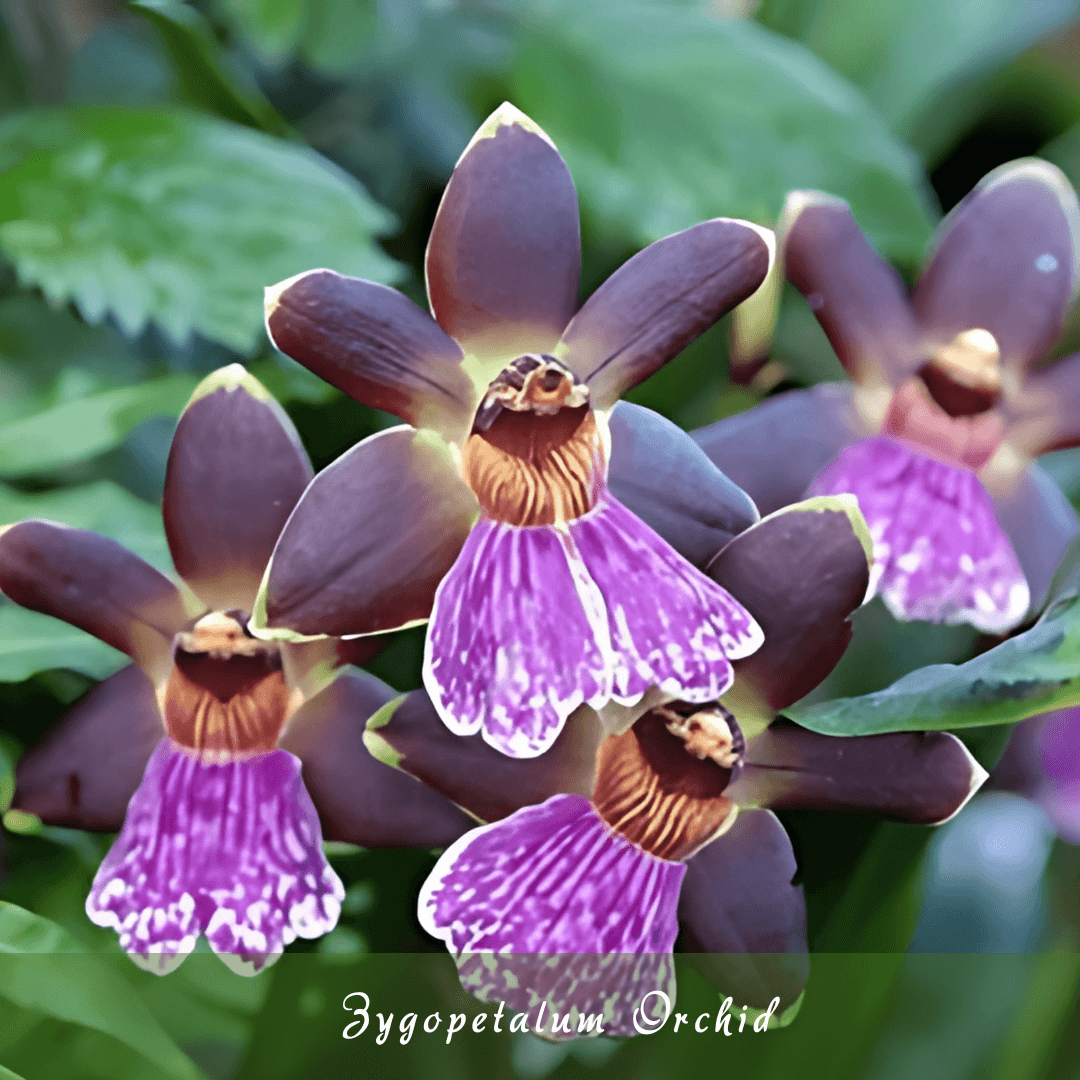
9. Zygopetalum Orchid
Growing Zone
USDA Zones 10-11. These orchids are prized for their bold, fragrant flowers, which feature striking combinations of green, purple, maroon, and blue hues.
Their petals often display intricate patterns, while the lip (labellum) is typically a deep, velvety purple or blue with white streaks. The foliage is lush, with long, arching green leaves that enhance their tropical appearance.
How To Grow
Zygopetalum orchids prefer bright, indirect light and temperatures between 60-80°F (16 and 27°C). Water when the mix is dry to ensure proper drainage.
Use a well-draining orchid mix and fertilize every two weeks during active growth. Maintain humidity around 50-60%. Repot every two to three years and trim spent flower spikes to encourage future blooms.
Care Tips
Maintain humidity between 50% and 70% and water only when the potting mix is dry. Fertilize bi-weekly during the growing season.
Ensure good airflow and a well-draining potting medium to prevent root rot and promote healthy blooms. Avoid overwatering to maintain plant health.
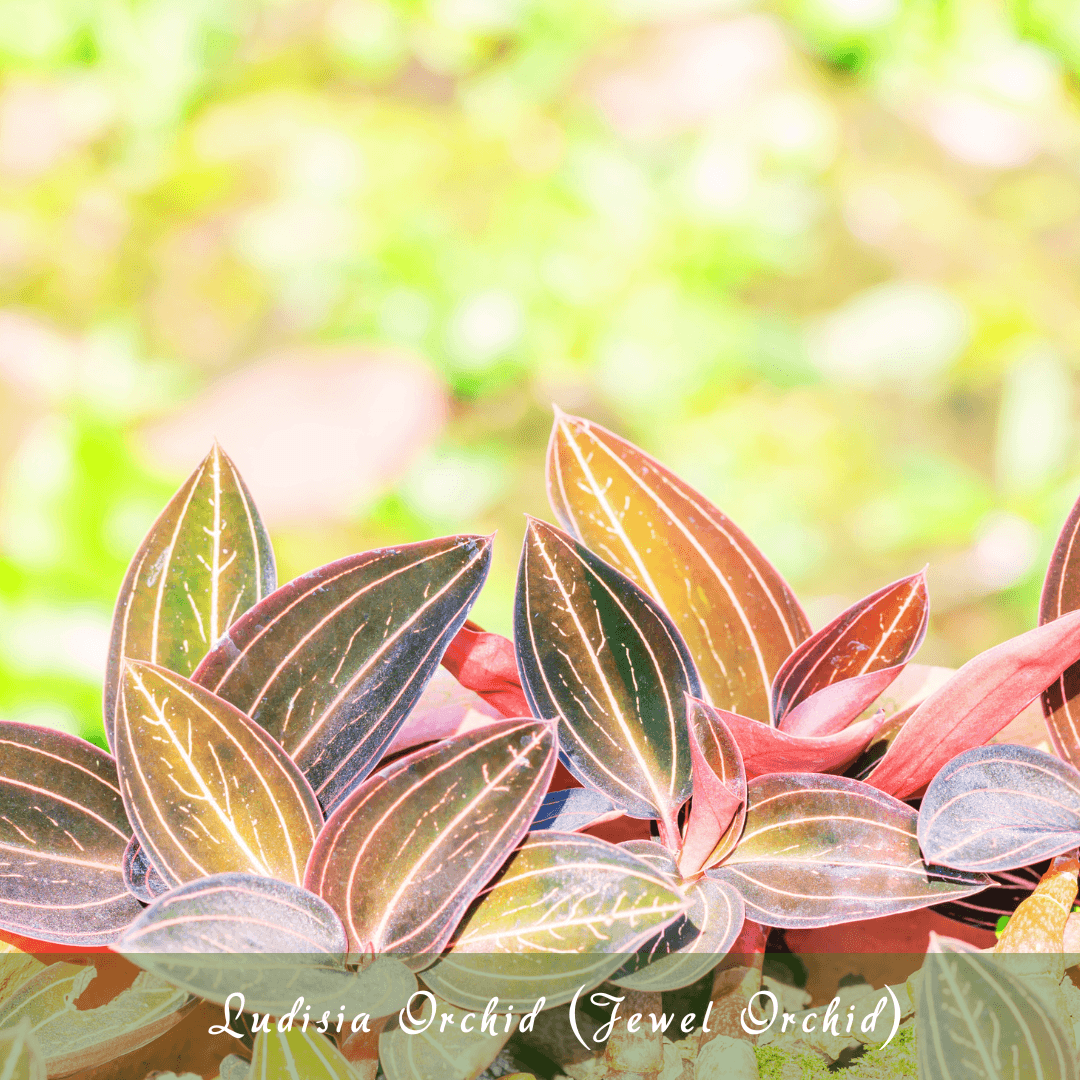
10. Ludisia Orchid (Jewel Orchid)
Growing Zone
USDA Zones 10-11. Ludisia orchids are known for their striking foliage rather than their flowers. Their leaves are dark green to purple with an intricate network of silver veins, giving them a jewel-like appearance.
While their flowers are small and delicate, they bloom in spikes of white or pink, adding an elegant contrast to the rich foliage.
How To Grow
Ludisia orchids prefer low to moderate light and temperatures between 65-80°F (18 and 27°C). Water when the soil is dry to ensure proper drainage.
Use a well-draining, moisture-retentive mix like sphagnum moss. Fertilize monthly during active growth. Maintain humidity around 50-60%. Repot every 2 to 3 years and remove spent or damaged growth to promote healthy development.
Care Tips
Water when the potting mix feels dry, ensuring the soil is not overly moist. Fertilize once a month throughout the growing season to encourage healthy growth.
These orchids also enjoy higher humidity levels, so occasional misting can help maintain vitality and promote blooming.
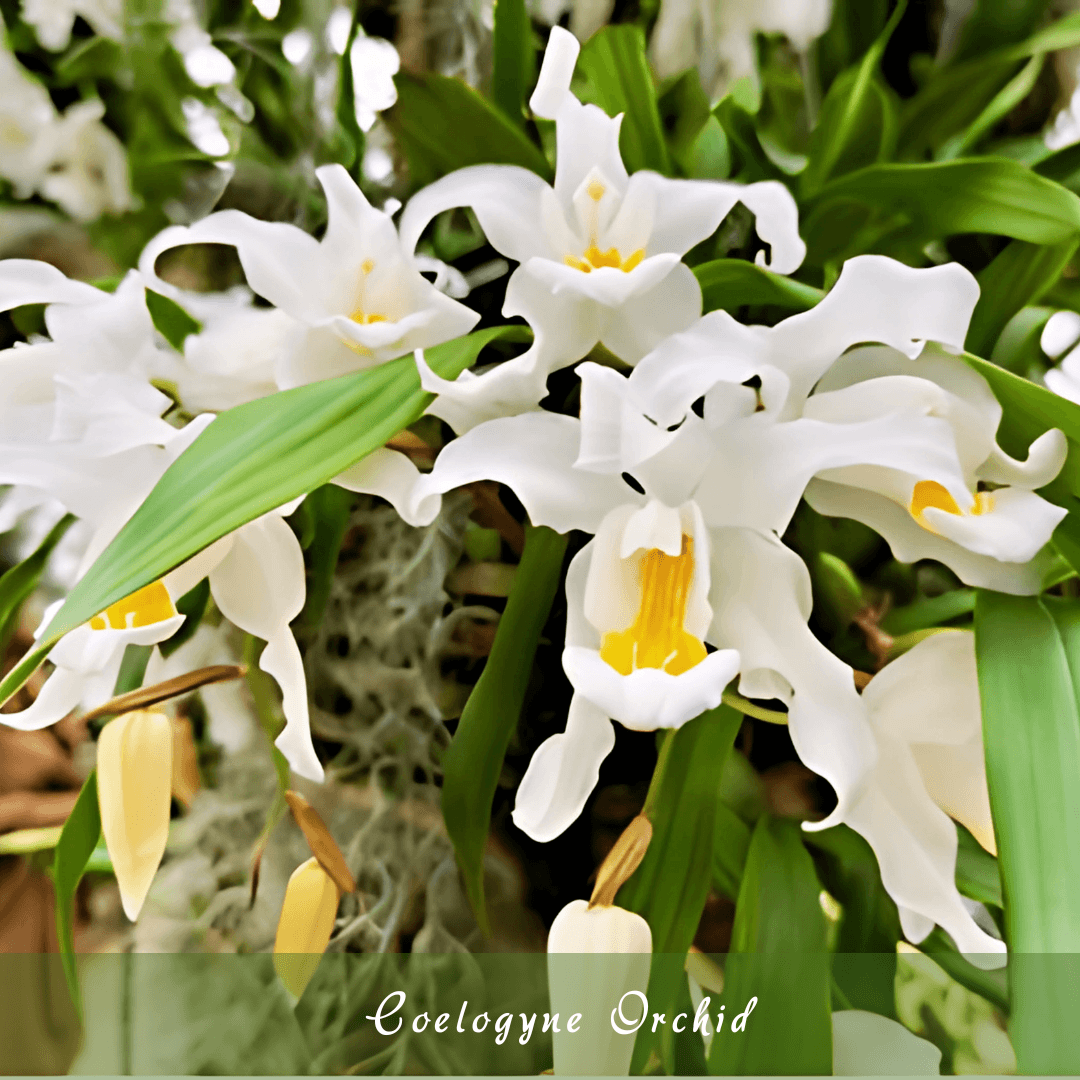
11. Coelogyne Orchid
Growing Zone
USDA Zones 10-11. Coelogyne orchids are distinguished by their elegant, creamy white or yellow flowers with green or brown markings. The blooms are often large and showy, with a delicate fragrance. The plant has narrow, arching leaves, giving it a graceful, tropical appearance.
How To Grow
Coelogyne orchids thrive in bright, indirect light and temperatures between 60-75°F (15 and 24°C). Water when the potting mix is dry to ensure good drainage.
Use a well-draining mix like bark or sphagnum moss. Fertilize monthly during growth. Maintain humidity around 50-60%. Repot every 2 to 3 years and trim spent flower spikes to encourage new blooms.
Care Tips
For healthy indoor orchid plants, water moderately, maintain humidity around 50-60%, fertilize monthly during the growing season, and ensure a winter rest period to encourage blooming. Also, prune spent blooms for fresh growth.
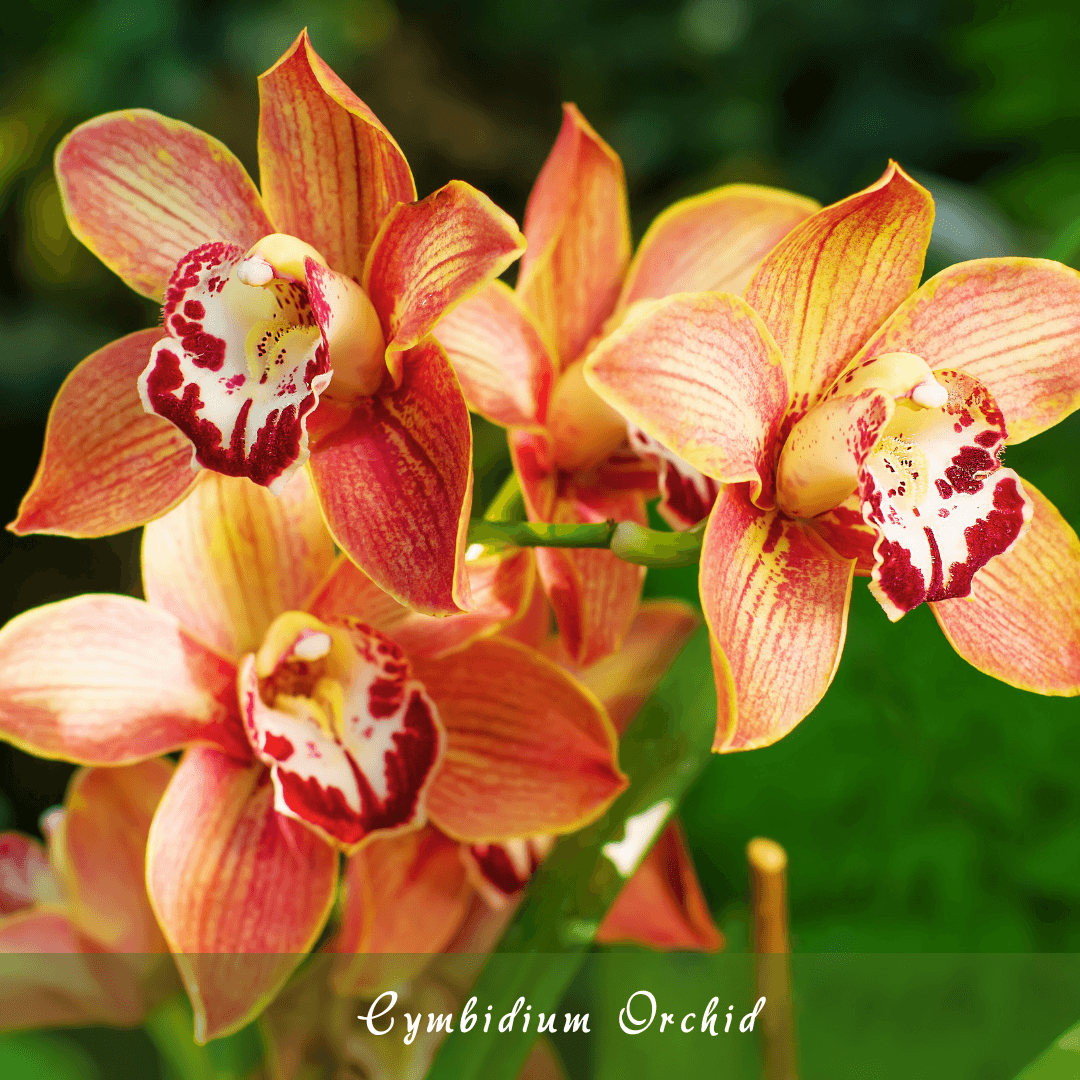
12. Cymbidium Orchid
Growing Zone
USDA Zones 10-11. Cymbidium orchids are known for their large, showy flowers in a wide range of colours, including white, yellow, pink, red, and green, often with contrasting lip markings.
The flowers are borne on tall, arching spikes, and the plant has long, narrow, strap-like leaves that give it an elegant, grass-like appearance.
How To Grow
Cymbidium orchids prefer bright, indirect light and temperatures between 50-70°F (10 and 21°C). Water when the mix is dry to ensure good drainage.
Use a well-draining mix like bark or perlite. Fertilize every two weeks during active growth. Maintain humidity around 50-60%. Repot every two to three years and trim spent flower spikes to encourage reblooming.
Care Tips
Water when the medium is dry, ensuring proper drainage to prevent root rot. Fertilize monthly during the growing season.
Maintain high humidity for healthy roots and blooms, and avoid overly wet conditions. Providing cooler nighttime temperatures encourages flowering and overall plant health.
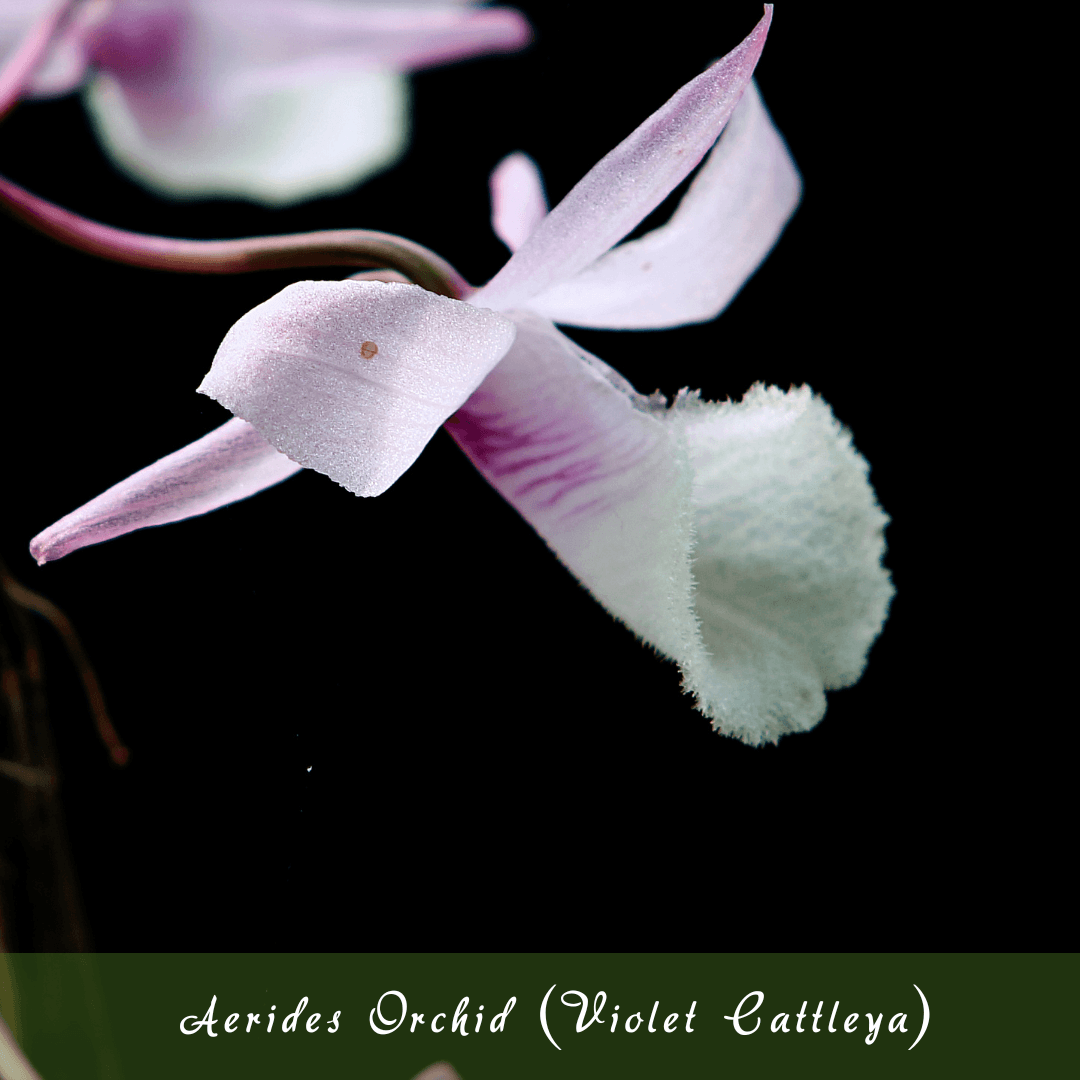
13. Aerides Orchid (Fox Brush Orchid)
Growing Zone
USDA Zones 10-11. Aerides orchids are known for their striking violet to lavender flowers, often with a fragrant, sweet aroma.
The flowers typically have a narrow, elongated shape with a prominent lip. The plant has long, slender leaves and can grow in a cascading form, making it visually appealing when grown in hanging baskets or containers.
How To Grow
Aerides orchids thrive in bright, indirect light and temperatures between 70-85°F (21 and 29°C). Water regularly, allowing the roots to dry between waterings.
Use a well-draining orchid mix, such as bark or sphagnum moss. Fertilize every two weeks during growth. Maintain humidity around 50-60%. Repot every two to three years and trim spent flower spikes.
Care Tips
Water when the medium feels dry, ensuring proper drainage to avoid waterlogging. These orchids thrive in high humidity, so regular misting is beneficial.
Fertilize weekly during the growing season to promote healthy growth and vibrant blooms, avoiding excessive feeding during rest periods.
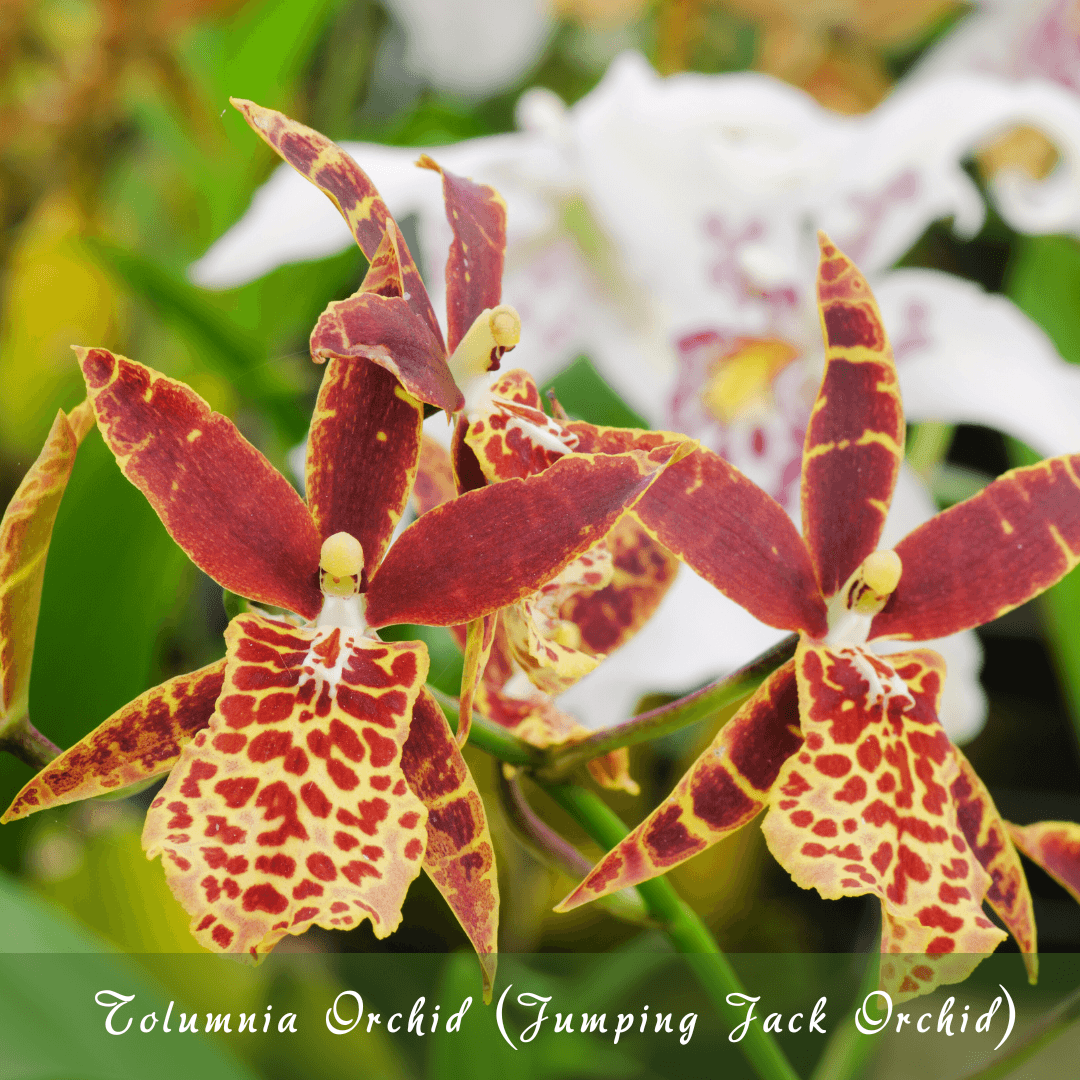
14. Tolumnia Orchid (Jumping Jack Orchid)
Growing Zone
USDA Zones 10-11. Tolumnia orchids have small, vibrant flowers that come in various colours, including bright yellows, pinks, reds, and purples, often with intricate markings.
The flowers are typically arranged in dense clusters, giving them a striking, showy appearance. The plant itself is compact, with narrow leaves that grow in a rosette pattern, making it ideal for hanging baskets or containers.
How To Grow
Tolumnia orchids prefer bright, indirect light and warm temperatures between 70-85°F (21-29°C). Water when the potting mix is dry to ensure good drainage.
Use a well-draining mix like orchid bark or sphagnum moss. Fertilize every two weeks during growth. Maintain humidity around 50-60%. Repot every 1 to 2 years and trim spent flower spikes to encourage reblooming.
Care Tips
Water when the medium feels dry, avoiding overwatering, as these orchids are prone to root rot. Maintain humidity around 50-60% and mist occasionally. Fertilize your orchids once a month for healthy development and lots of flowers.
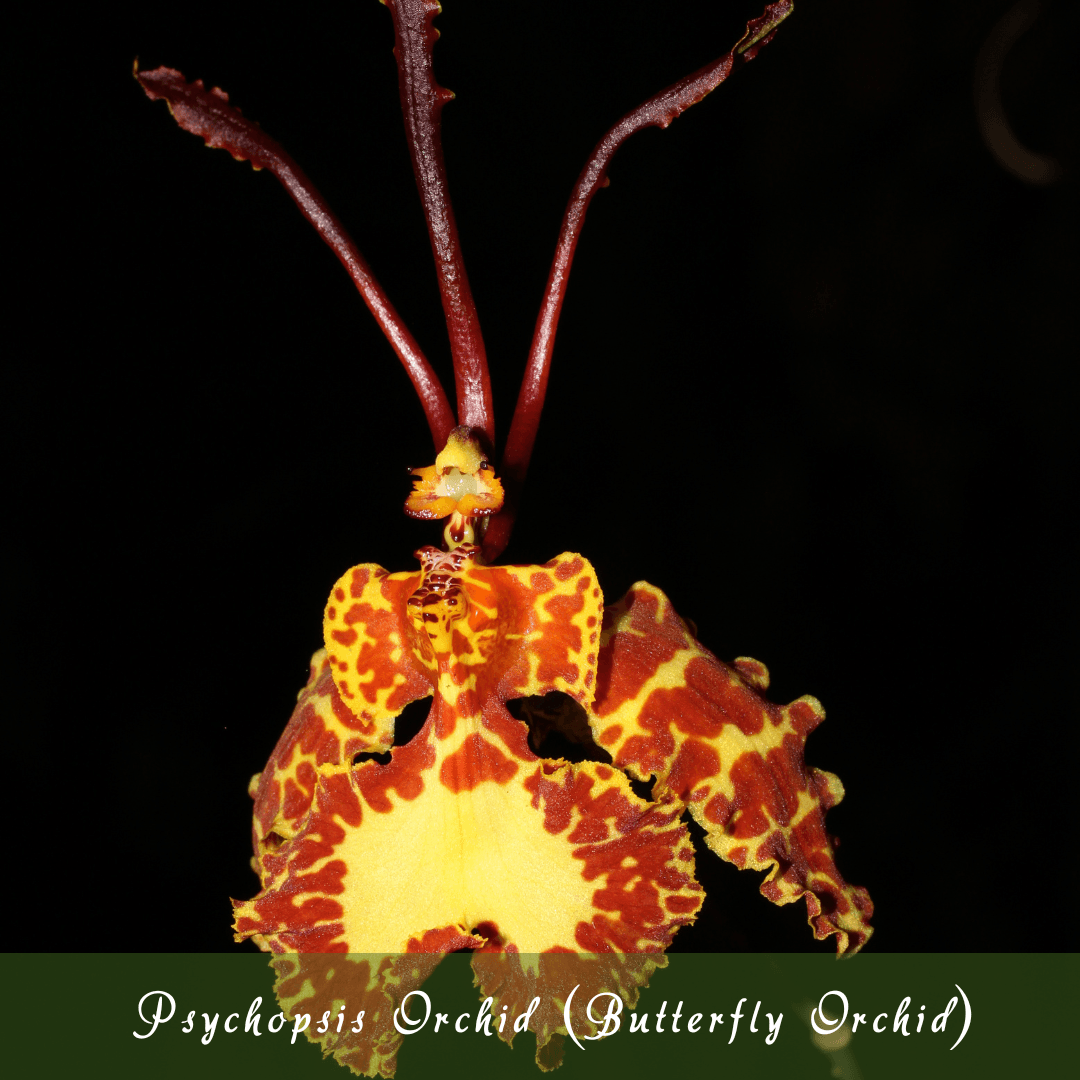
15. Psychopsis Orchid (Butterfly Orchid)
Growing Zone
USDA Zones 10-11. Psychopsis orchids are known for their striking butterfly-like flowers, which have long, narrow petals that create a unique, dramatic shape.
The flowers typically appear in shades of yellow, orange, and red with intricate patterns, making them quite eye-catching.
The plant itself has long, arching leaves and tall flower spikes that bloom repeatedly on the same spike, offering an extended flowering period.
How To Grow
Psychopsis orchids thrive in bright, indirect light and temperatures between 60-85°F (15-29°C). Water when the mix is dry, ensuring good drainage.
Use a well-draining mix like bark or sphagnum moss. Fertilize every 2 weeks during active growth. Maintain humidity around 50-60%. Repot every 2-3 years and trim spent flower spikes to encourage new blooms.
Care Tips
Psychopsis orchids are unique indoor orchid plants that thrive with high humidity, regular misting, and monthly fertilization during the growing season, continuing to produce flowers on the same spike for months after blooming.
Fertilize monthly during the growing season. After blooming, Psychopsis orchids often grow flowers on the same spike for months.
Conclusion
In conclusion, indoor orchid plants are a stunning and rewarding addition to any home. With proper care—appropriate light, humidity, and watering—these plants can thrive for years and enhance your space with their beauty.
By choosing the right variety and following care guidelines, you can enjoy their long-lasting blooms and reap numerous benefits, from air purification to stress relief. Cultivating orchids brings joy and elegance to your indoor environment.
I trust you enjoyed this Indoor Orchid Plants That Transform Your Space article. Please stay tuned for more blog posts soon. Take care!
JeannetteZ
>>>Please click here to read my all-inclusive article, About The Essential Companion Planting Guide<<<
>>>Please click here to read my all-inclusive article about Container Gardening<<<
>>>Are you interested in homegrown herbs and medicine? Please click here to find out more about it!<<<
Your Opinion Is Important To Me
Do you have thoughts, ideas, or questions? I would love to hear from you. Please leave me your questions, experiences, and remarks about this article, Indoor Orchid Plants That Transform Your Spaces, in the comments section below. You can also email me at Jeannette@Close-To-Nature.org.
Disclosure
This post may contain affiliate links. As an Amazon Associate and other affiliate programs, I earn from qualifying purchases at no extra cost to you. Please read my full affiliate disclosure.
You might also enjoy these blog posts:
A Comprehensive Guide To The Types Of Orchid Plant
A Guide To The Various Types Of Bromeliad Plants
Stunning Types Of Dahlia Plants You’ll Love
How To Stop Anxiety Attacks Fast
Brilliant Cactus Gardening Ideas To Elevate Your Space
How To Grow Dahlia Plants For Stunning Blooms
Bromeliad Plant Care: From Vibrant Blooms To Propagating Pups


